Mental Health and Wellbeing of Emergency Workers During COVID-19
VerifiedAdded on 2023/01/03
|10
|3341
|76
Report
AI Summary
This report investigates the crucial link between mental and physical health, particularly within the context of emergency service workers during the COVID-19 pandemic. It identifies social and psychological factors impacting these workers, such as stress and hopelessness, and explores the PERMA model to promote wellbeing. The report examines early warning signs of stress, the benefits of early intervention strategies, and effective social media strategies to build resilience. It also outlines methods for supervising workers' mental health post-COVID-19 and provides practical tips to help emergency service workers remain stress-free. The report highlights the interconnectedness of mental and physical health, the importance of early intervention, and the role of social media in supporting emergency responders.
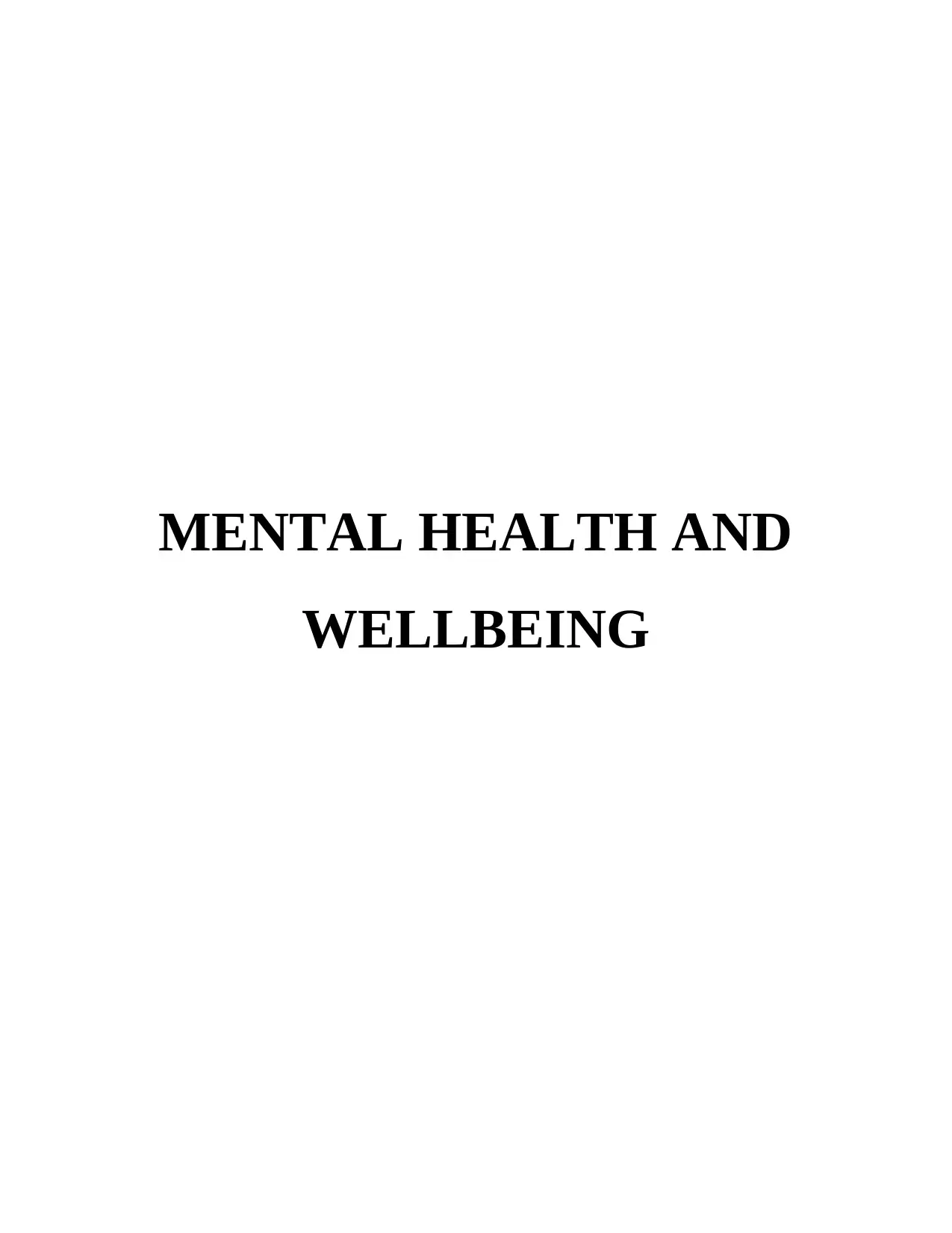
MENTAL HEALTH AND
WELLBEING
WELLBEING
Paraphrase This Document
Need a fresh take? Get an instant paraphrase of this document with our AI Paraphraser
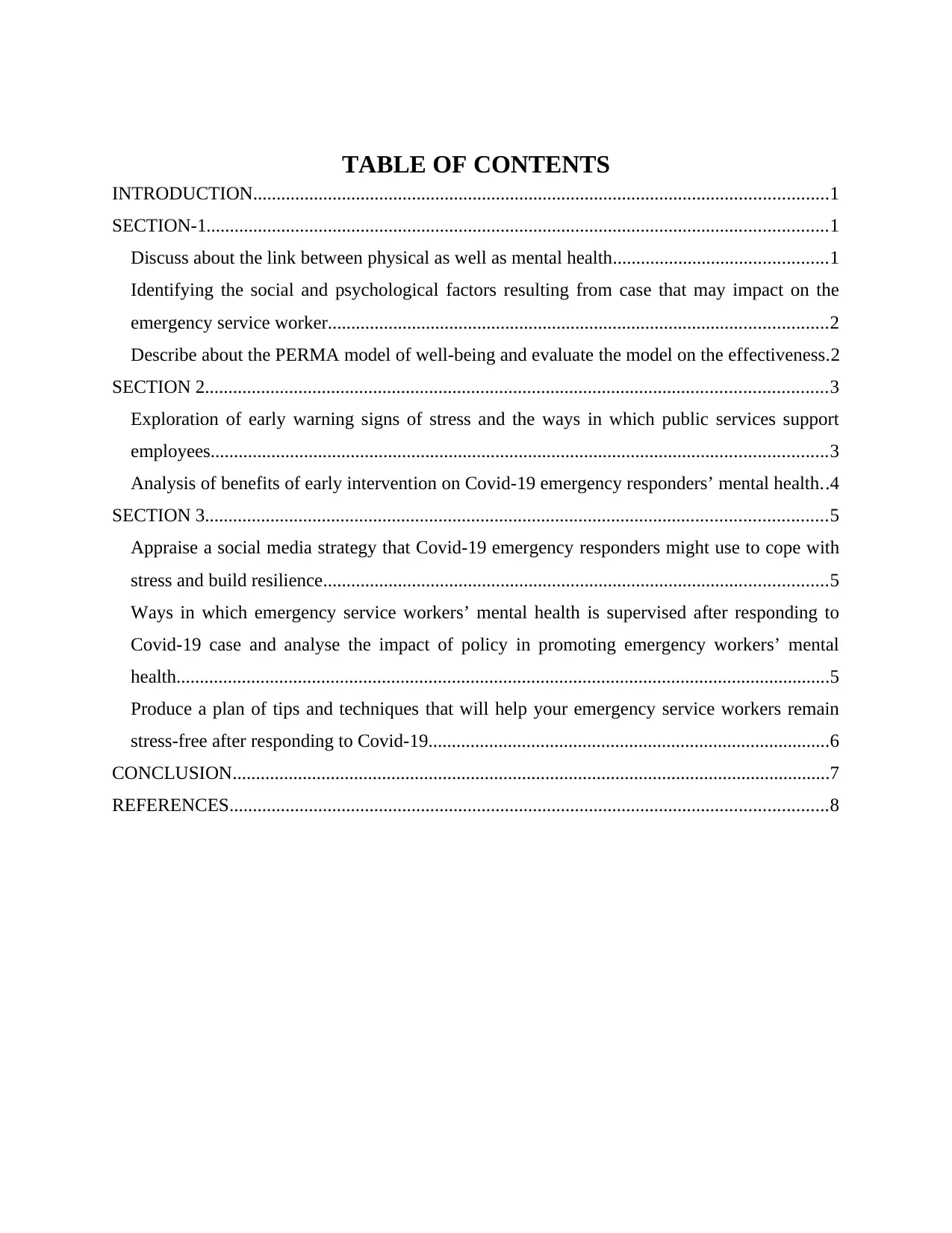
TABLE OF CONTENTS
INTRODUCTION...........................................................................................................................1
SECTION-1.....................................................................................................................................1
Discuss about the link between physical as well as mental health..............................................1
Identifying the social and psychological factors resulting from case that may impact on the
emergency service worker...........................................................................................................2
Describe about the PERMA model of well-being and evaluate the model on the effectiveness.2
SECTION 2.....................................................................................................................................3
Exploration of early warning signs of stress and the ways in which public services support
employees....................................................................................................................................3
Analysis of benefits of early intervention on Covid-19 emergency responders’ mental health..4
SECTION 3.....................................................................................................................................5
Appraise a social media strategy that Covid-19 emergency responders might use to cope with
stress and build resilience............................................................................................................5
Ways in which emergency service workers’ mental health is supervised after responding to
Covid-19 case and analyse the impact of policy in promoting emergency workers’ mental
health............................................................................................................................................5
Produce a plan of tips and techniques that will help your emergency service workers remain
stress-free after responding to Covid-19......................................................................................6
CONCLUSION................................................................................................................................7
REFERENCES................................................................................................................................8
INTRODUCTION...........................................................................................................................1
SECTION-1.....................................................................................................................................1
Discuss about the link between physical as well as mental health..............................................1
Identifying the social and psychological factors resulting from case that may impact on the
emergency service worker...........................................................................................................2
Describe about the PERMA model of well-being and evaluate the model on the effectiveness.2
SECTION 2.....................................................................................................................................3
Exploration of early warning signs of stress and the ways in which public services support
employees....................................................................................................................................3
Analysis of benefits of early intervention on Covid-19 emergency responders’ mental health..4
SECTION 3.....................................................................................................................................5
Appraise a social media strategy that Covid-19 emergency responders might use to cope with
stress and build resilience............................................................................................................5
Ways in which emergency service workers’ mental health is supervised after responding to
Covid-19 case and analyse the impact of policy in promoting emergency workers’ mental
health............................................................................................................................................5
Produce a plan of tips and techniques that will help your emergency service workers remain
stress-free after responding to Covid-19......................................................................................6
CONCLUSION................................................................................................................................7
REFERENCES................................................................................................................................8
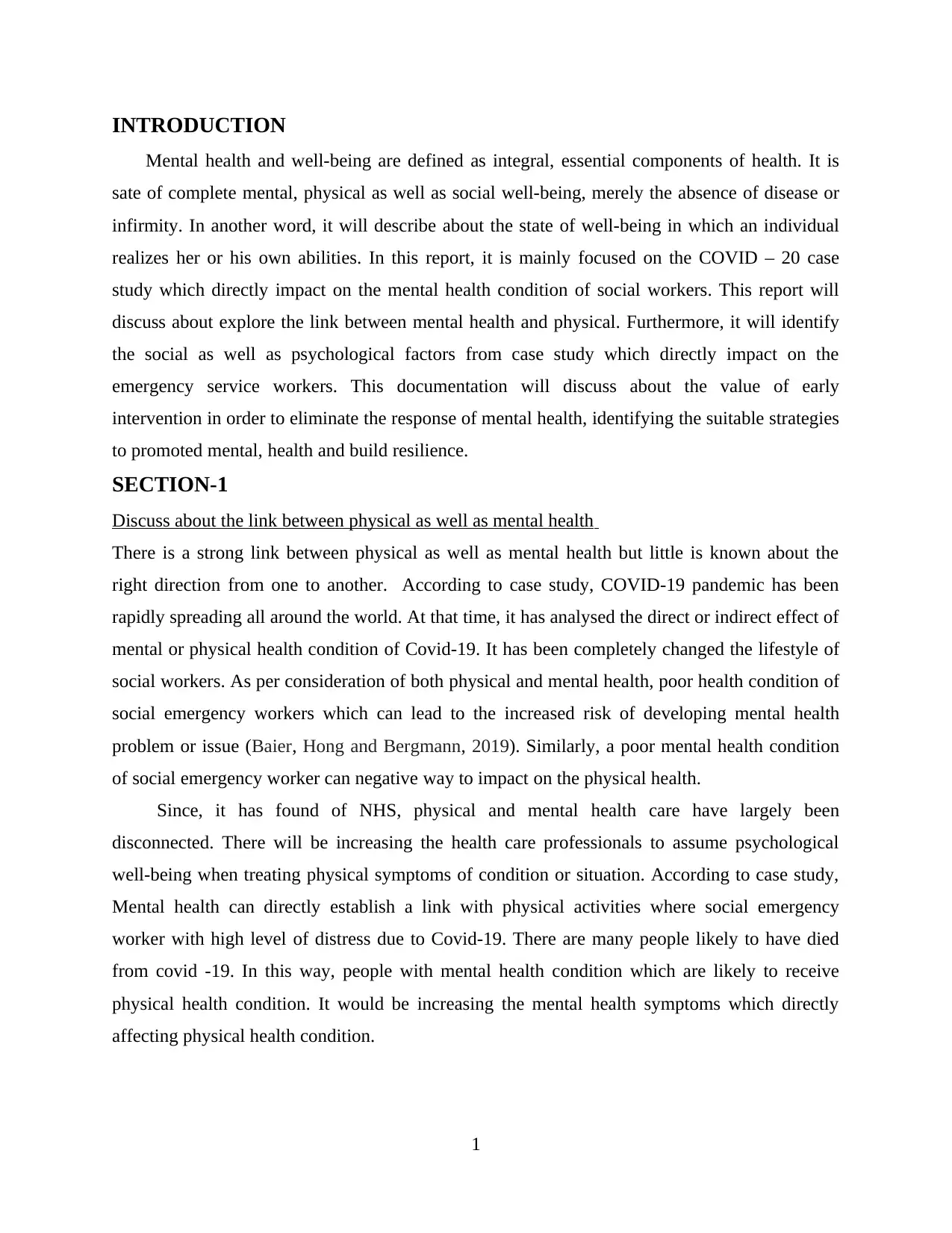
INTRODUCTION
Mental health and well-being are defined as integral, essential components of health. It is
sate of complete mental, physical as well as social well-being, merely the absence of disease or
infirmity. In another word, it will describe about the state of well-being in which an individual
realizes her or his own abilities. In this report, it is mainly focused on the COVID – 20 case
study which directly impact on the mental health condition of social workers. This report will
discuss about explore the link between mental health and physical. Furthermore, it will identify
the social as well as psychological factors from case study which directly impact on the
emergency service workers. This documentation will discuss about the value of early
intervention in order to eliminate the response of mental health, identifying the suitable strategies
to promoted mental, health and build resilience.
SECTION-1
Discuss about the link between physical as well as mental health
There is a strong link between physical as well as mental health but little is known about the
right direction from one to another. According to case study, COVID-19 pandemic has been
rapidly spreading all around the world. At that time, it has analysed the direct or indirect effect of
mental or physical health condition of Covid-19. It has been completely changed the lifestyle of
social workers. As per consideration of both physical and mental health, poor health condition of
social emergency workers which can lead to the increased risk of developing mental health
problem or issue (Baier, Hong and Bergmann, 2019). Similarly, a poor mental health condition
of social emergency worker can negative way to impact on the physical health.
Since, it has found of NHS, physical and mental health care have largely been
disconnected. There will be increasing the health care professionals to assume psychological
well-being when treating physical symptoms of condition or situation. According to case study,
Mental health can directly establish a link with physical activities where social emergency
worker with high level of distress due to Covid-19. There are many people likely to have died
from covid -19. In this way, people with mental health condition which are likely to receive
physical health condition. It would be increasing the mental health symptoms which directly
affecting physical health condition.
1
Mental health and well-being are defined as integral, essential components of health. It is
sate of complete mental, physical as well as social well-being, merely the absence of disease or
infirmity. In another word, it will describe about the state of well-being in which an individual
realizes her or his own abilities. In this report, it is mainly focused on the COVID – 20 case
study which directly impact on the mental health condition of social workers. This report will
discuss about explore the link between mental health and physical. Furthermore, it will identify
the social as well as psychological factors from case study which directly impact on the
emergency service workers. This documentation will discuss about the value of early
intervention in order to eliminate the response of mental health, identifying the suitable strategies
to promoted mental, health and build resilience.
SECTION-1
Discuss about the link between physical as well as mental health
There is a strong link between physical as well as mental health but little is known about the
right direction from one to another. According to case study, COVID-19 pandemic has been
rapidly spreading all around the world. At that time, it has analysed the direct or indirect effect of
mental or physical health condition of Covid-19. It has been completely changed the lifestyle of
social workers. As per consideration of both physical and mental health, poor health condition of
social emergency workers which can lead to the increased risk of developing mental health
problem or issue (Baier, Hong and Bergmann, 2019). Similarly, a poor mental health condition
of social emergency worker can negative way to impact on the physical health.
Since, it has found of NHS, physical and mental health care have largely been
disconnected. There will be increasing the health care professionals to assume psychological
well-being when treating physical symptoms of condition or situation. According to case study,
Mental health can directly establish a link with physical activities where social emergency
worker with high level of distress due to Covid-19. There are many people likely to have died
from covid -19. In this way, people with mental health condition which are likely to receive
physical health condition. It would be increasing the mental health symptoms which directly
affecting physical health condition.
1
⊘ This is a preview!⊘
Do you want full access?
Subscribe today to unlock all pages.

Trusted by 1+ million students worldwide
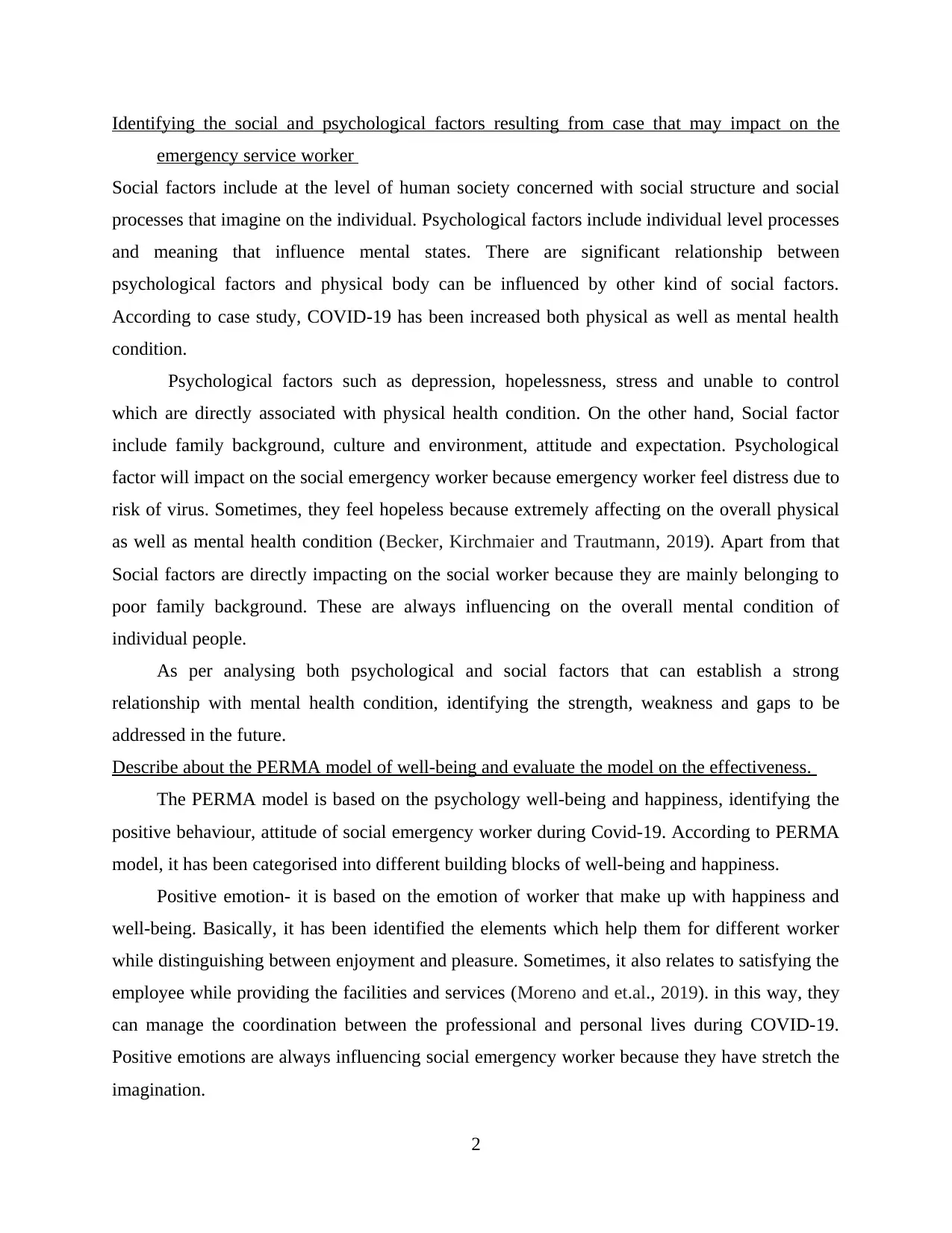
Identifying the social and psychological factors resulting from case that may impact on the
emergency service worker
Social factors include at the level of human society concerned with social structure and social
processes that imagine on the individual. Psychological factors include individual level processes
and meaning that influence mental states. There are significant relationship between
psychological factors and physical body can be influenced by other kind of social factors.
According to case study, COVID-19 has been increased both physical as well as mental health
condition.
Psychological factors such as depression, hopelessness, stress and unable to control
which are directly associated with physical health condition. On the other hand, Social factor
include family background, culture and environment, attitude and expectation. Psychological
factor will impact on the social emergency worker because emergency worker feel distress due to
risk of virus. Sometimes, they feel hopeless because extremely affecting on the overall physical
as well as mental health condition (Becker, Kirchmaier and Trautmann, 2019). Apart from that
Social factors are directly impacting on the social worker because they are mainly belonging to
poor family background. These are always influencing on the overall mental condition of
individual people.
As per analysing both psychological and social factors that can establish a strong
relationship with mental health condition, identifying the strength, weakness and gaps to be
addressed in the future.
Describe about the PERMA model of well-being and evaluate the model on the effectiveness.
The PERMA model is based on the psychology well-being and happiness, identifying the
positive behaviour, attitude of social emergency worker during Covid-19. According to PERMA
model, it has been categorised into different building blocks of well-being and happiness.
Positive emotion- it is based on the emotion of worker that make up with happiness and
well-being. Basically, it has been identified the elements which help them for different worker
while distinguishing between enjoyment and pleasure. Sometimes, it also relates to satisfying the
employee while providing the facilities and services (Moreno and et.al., 2019). in this way, they
can manage the coordination between the professional and personal lives during COVID-19.
Positive emotions are always influencing social emergency worker because they have stretch the
imagination.
2
emergency service worker
Social factors include at the level of human society concerned with social structure and social
processes that imagine on the individual. Psychological factors include individual level processes
and meaning that influence mental states. There are significant relationship between
psychological factors and physical body can be influenced by other kind of social factors.
According to case study, COVID-19 has been increased both physical as well as mental health
condition.
Psychological factors such as depression, hopelessness, stress and unable to control
which are directly associated with physical health condition. On the other hand, Social factor
include family background, culture and environment, attitude and expectation. Psychological
factor will impact on the social emergency worker because emergency worker feel distress due to
risk of virus. Sometimes, they feel hopeless because extremely affecting on the overall physical
as well as mental health condition (Becker, Kirchmaier and Trautmann, 2019). Apart from that
Social factors are directly impacting on the social worker because they are mainly belonging to
poor family background. These are always influencing on the overall mental condition of
individual people.
As per analysing both psychological and social factors that can establish a strong
relationship with mental health condition, identifying the strength, weakness and gaps to be
addressed in the future.
Describe about the PERMA model of well-being and evaluate the model on the effectiveness.
The PERMA model is based on the psychology well-being and happiness, identifying the
positive behaviour, attitude of social emergency worker during Covid-19. According to PERMA
model, it has been categorised into different building blocks of well-being and happiness.
Positive emotion- it is based on the emotion of worker that make up with happiness and
well-being. Basically, it has been identified the elements which help them for different worker
while distinguishing between enjoyment and pleasure. Sometimes, it also relates to satisfying the
employee while providing the facilities and services (Moreno and et.al., 2019). in this way, they
can manage the coordination between the professional and personal lives during COVID-19.
Positive emotions are always influencing social emergency worker because they have stretch the
imagination.
2
Paraphrase This Document
Need a fresh take? Get an instant paraphrase of this document with our AI Paraphraser
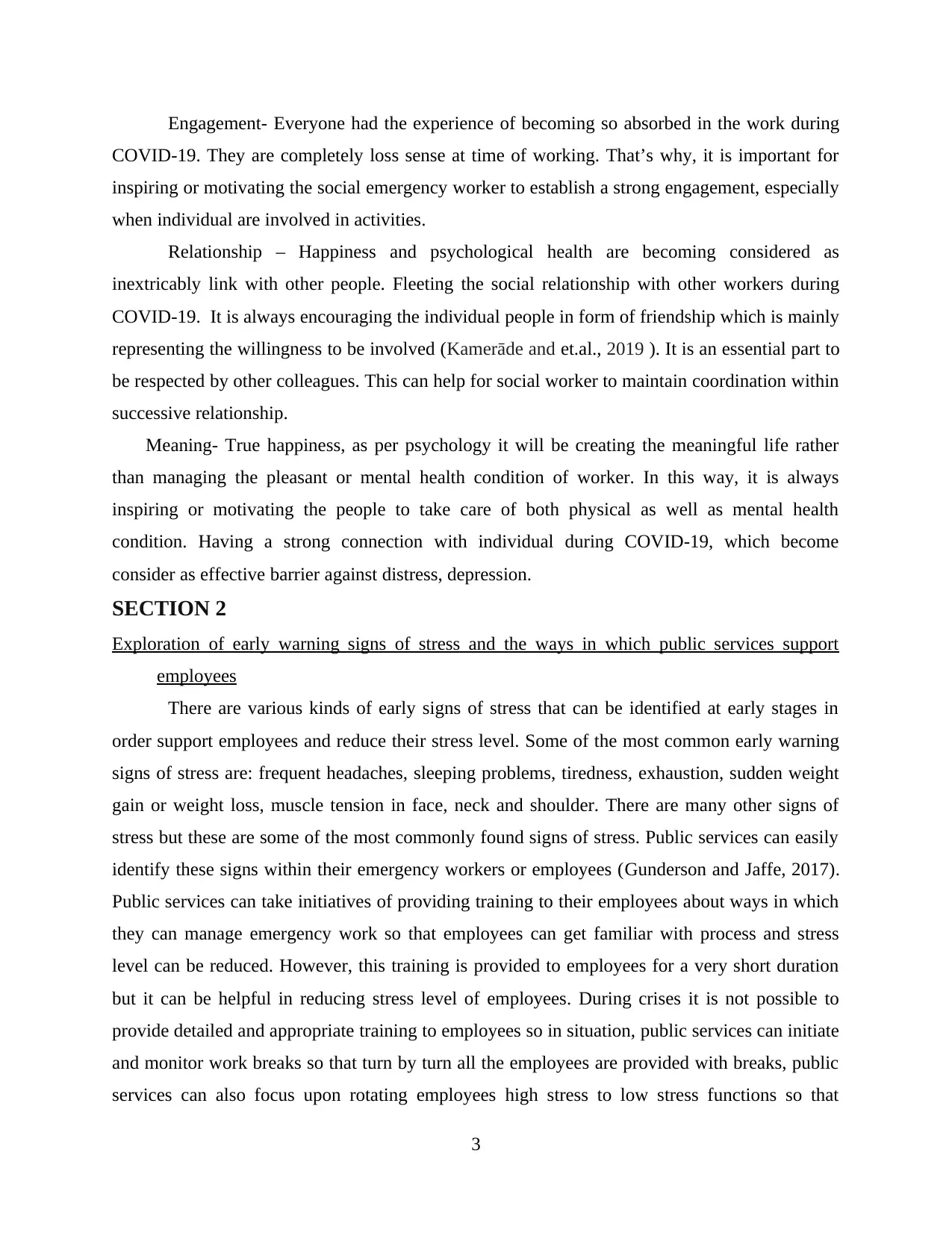
Engagement- Everyone had the experience of becoming so absorbed in the work during
COVID-19. They are completely loss sense at time of working. That’s why, it is important for
inspiring or motivating the social emergency worker to establish a strong engagement, especially
when individual are involved in activities.
Relationship – Happiness and psychological health are becoming considered as
inextricably link with other people. Fleeting the social relationship with other workers during
COVID-19. It is always encouraging the individual people in form of friendship which is mainly
representing the willingness to be involved (Kamerāde and et.al., 2019 ). It is an essential part to
be respected by other colleagues. This can help for social worker to maintain coordination within
successive relationship.
Meaning- True happiness, as per psychology it will be creating the meaningful life rather
than managing the pleasant or mental health condition of worker. In this way, it is always
inspiring or motivating the people to take care of both physical as well as mental health
condition. Having a strong connection with individual during COVID-19, which become
consider as effective barrier against distress, depression.
SECTION 2
Exploration of early warning signs of stress and the ways in which public services support
employees
There are various kinds of early signs of stress that can be identified at early stages in
order support employees and reduce their stress level. Some of the most common early warning
signs of stress are: frequent headaches, sleeping problems, tiredness, exhaustion, sudden weight
gain or weight loss, muscle tension in face, neck and shoulder. There are many other signs of
stress but these are some of the most commonly found signs of stress. Public services can easily
identify these signs within their emergency workers or employees (Gunderson and Jaffe, 2017).
Public services can take initiatives of providing training to their employees about ways in which
they can manage emergency work so that employees can get familiar with process and stress
level can be reduced. However, this training is provided to employees for a very short duration
but it can be helpful in reducing stress level of employees. During crises it is not possible to
provide detailed and appropriate training to employees so in situation, public services can initiate
and monitor work breaks so that turn by turn all the employees are provided with breaks, public
services can also focus upon rotating employees high stress to low stress functions so that
3
COVID-19. They are completely loss sense at time of working. That’s why, it is important for
inspiring or motivating the social emergency worker to establish a strong engagement, especially
when individual are involved in activities.
Relationship – Happiness and psychological health are becoming considered as
inextricably link with other people. Fleeting the social relationship with other workers during
COVID-19. It is always encouraging the individual people in form of friendship which is mainly
representing the willingness to be involved (Kamerāde and et.al., 2019 ). It is an essential part to
be respected by other colleagues. This can help for social worker to maintain coordination within
successive relationship.
Meaning- True happiness, as per psychology it will be creating the meaningful life rather
than managing the pleasant or mental health condition of worker. In this way, it is always
inspiring or motivating the people to take care of both physical as well as mental health
condition. Having a strong connection with individual during COVID-19, which become
consider as effective barrier against distress, depression.
SECTION 2
Exploration of early warning signs of stress and the ways in which public services support
employees
There are various kinds of early signs of stress that can be identified at early stages in
order support employees and reduce their stress level. Some of the most common early warning
signs of stress are: frequent headaches, sleeping problems, tiredness, exhaustion, sudden weight
gain or weight loss, muscle tension in face, neck and shoulder. There are many other signs of
stress but these are some of the most commonly found signs of stress. Public services can easily
identify these signs within their emergency workers or employees (Gunderson and Jaffe, 2017).
Public services can take initiatives of providing training to their employees about ways in which
they can manage emergency work so that employees can get familiar with process and stress
level can be reduced. However, this training is provided to employees for a very short duration
but it can be helpful in reducing stress level of employees. During crises it is not possible to
provide detailed and appropriate training to employees so in situation, public services can initiate
and monitor work breaks so that turn by turn all the employees are provided with breaks, public
services can also focus upon rotating employees high stress to low stress functions so that
3
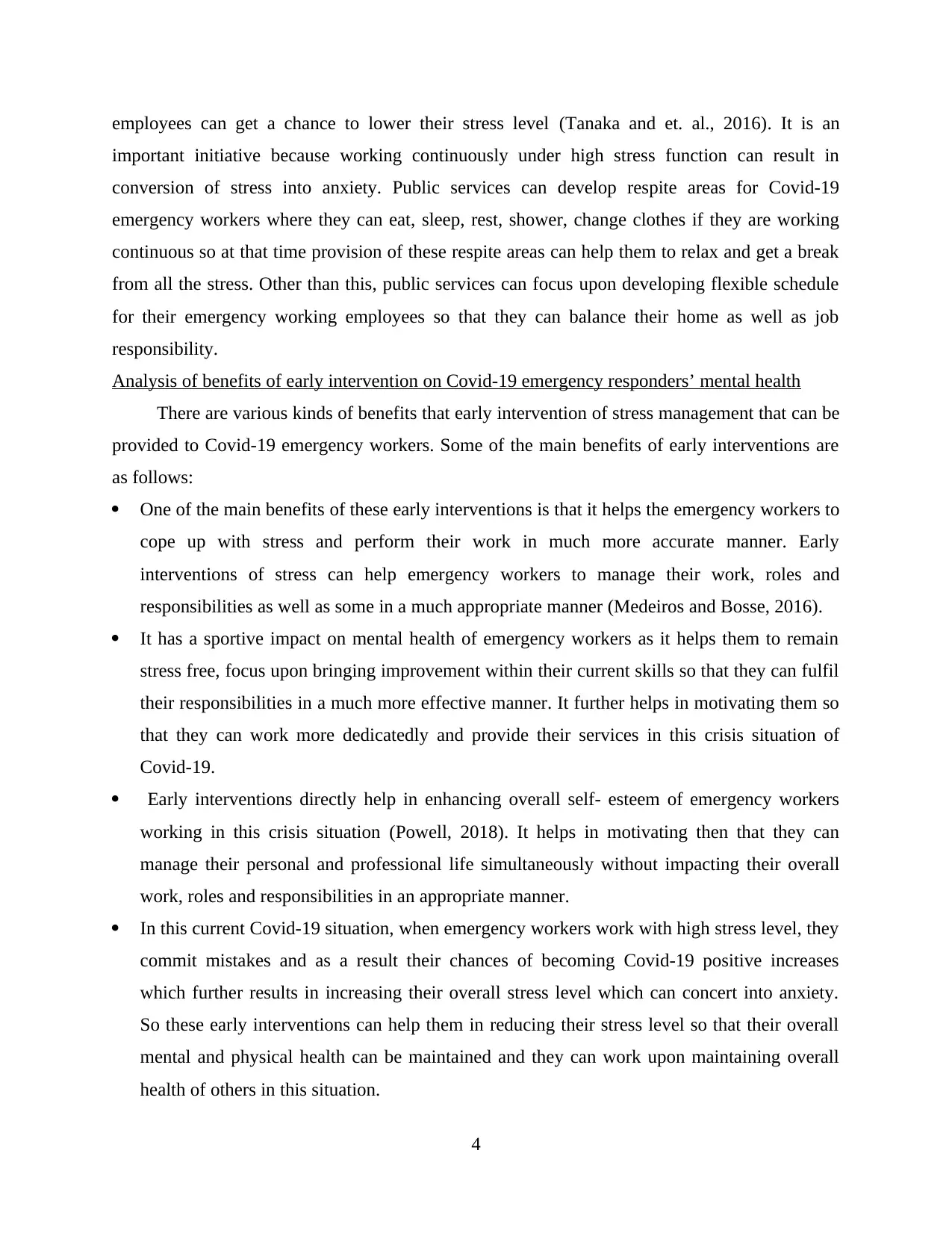
employees can get a chance to lower their stress level (Tanaka and et. al., 2016). It is an
important initiative because working continuously under high stress function can result in
conversion of stress into anxiety. Public services can develop respite areas for Covid-19
emergency workers where they can eat, sleep, rest, shower, change clothes if they are working
continuous so at that time provision of these respite areas can help them to relax and get a break
from all the stress. Other than this, public services can focus upon developing flexible schedule
for their emergency working employees so that they can balance their home as well as job
responsibility.
Analysis of benefits of early intervention on Covid-19 emergency responders’ mental health
There are various kinds of benefits that early intervention of stress management that can be
provided to Covid-19 emergency workers. Some of the main benefits of early interventions are
as follows:
One of the main benefits of these early interventions is that it helps the emergency workers to
cope up with stress and perform their work in much more accurate manner. Early
interventions of stress can help emergency workers to manage their work, roles and
responsibilities as well as some in a much appropriate manner (Medeiros and Bosse, 2016).
It has a sportive impact on mental health of emergency workers as it helps them to remain
stress free, focus upon bringing improvement within their current skills so that they can fulfil
their responsibilities in a much more effective manner. It further helps in motivating them so
that they can work more dedicatedly and provide their services in this crisis situation of
Covid-19.
Early interventions directly help in enhancing overall self- esteem of emergency workers
working in this crisis situation (Powell, 2018). It helps in motivating then that they can
manage their personal and professional life simultaneously without impacting their overall
work, roles and responsibilities in an appropriate manner.
In this current Covid-19 situation, when emergency workers work with high stress level, they
commit mistakes and as a result their chances of becoming Covid-19 positive increases
which further results in increasing their overall stress level which can concert into anxiety.
So these early interventions can help them in reducing their stress level so that their overall
mental and physical health can be maintained and they can work upon maintaining overall
health of others in this situation.
4
important initiative because working continuously under high stress function can result in
conversion of stress into anxiety. Public services can develop respite areas for Covid-19
emergency workers where they can eat, sleep, rest, shower, change clothes if they are working
continuous so at that time provision of these respite areas can help them to relax and get a break
from all the stress. Other than this, public services can focus upon developing flexible schedule
for their emergency working employees so that they can balance their home as well as job
responsibility.
Analysis of benefits of early intervention on Covid-19 emergency responders’ mental health
There are various kinds of benefits that early intervention of stress management that can be
provided to Covid-19 emergency workers. Some of the main benefits of early interventions are
as follows:
One of the main benefits of these early interventions is that it helps the emergency workers to
cope up with stress and perform their work in much more accurate manner. Early
interventions of stress can help emergency workers to manage their work, roles and
responsibilities as well as some in a much appropriate manner (Medeiros and Bosse, 2016).
It has a sportive impact on mental health of emergency workers as it helps them to remain
stress free, focus upon bringing improvement within their current skills so that they can fulfil
their responsibilities in a much more effective manner. It further helps in motivating them so
that they can work more dedicatedly and provide their services in this crisis situation of
Covid-19.
Early interventions directly help in enhancing overall self- esteem of emergency workers
working in this crisis situation (Powell, 2018). It helps in motivating then that they can
manage their personal and professional life simultaneously without impacting their overall
work, roles and responsibilities in an appropriate manner.
In this current Covid-19 situation, when emergency workers work with high stress level, they
commit mistakes and as a result their chances of becoming Covid-19 positive increases
which further results in increasing their overall stress level which can concert into anxiety.
So these early interventions can help them in reducing their stress level so that their overall
mental and physical health can be maintained and they can work upon maintaining overall
health of others in this situation.
4
⊘ This is a preview!⊘
Do you want full access?
Subscribe today to unlock all pages.

Trusted by 1+ million students worldwide
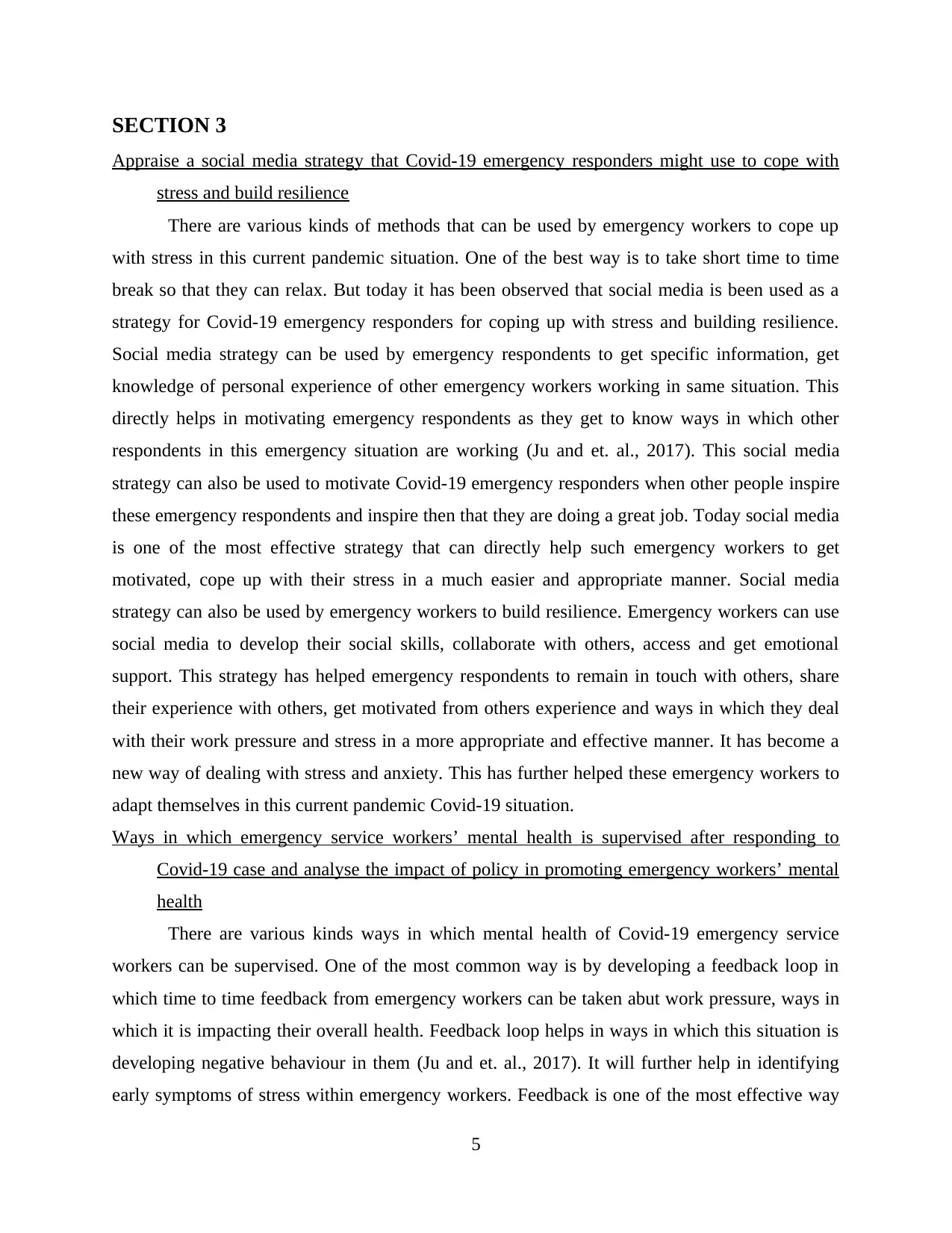
SECTION 3
Appraise a social media strategy that Covid-19 emergency responders might use to cope with
stress and build resilience
There are various kinds of methods that can be used by emergency workers to cope up
with stress in this current pandemic situation. One of the best way is to take short time to time
break so that they can relax. But today it has been observed that social media is been used as a
strategy for Covid-19 emergency responders for coping up with stress and building resilience.
Social media strategy can be used by emergency respondents to get specific information, get
knowledge of personal experience of other emergency workers working in same situation. This
directly helps in motivating emergency respondents as they get to know ways in which other
respondents in this emergency situation are working (Ju and et. al., 2017). This social media
strategy can also be used to motivate Covid-19 emergency responders when other people inspire
these emergency respondents and inspire then that they are doing a great job. Today social media
is one of the most effective strategy that can directly help such emergency workers to get
motivated, cope up with their stress in a much easier and appropriate manner. Social media
strategy can also be used by emergency workers to build resilience. Emergency workers can use
social media to develop their social skills, collaborate with others, access and get emotional
support. This strategy has helped emergency respondents to remain in touch with others, share
their experience with others, get motivated from others experience and ways in which they deal
with their work pressure and stress in a more appropriate and effective manner. It has become a
new way of dealing with stress and anxiety. This has further helped these emergency workers to
adapt themselves in this current pandemic Covid-19 situation.
Ways in which emergency service workers’ mental health is supervised after responding to
Covid-19 case and analyse the impact of policy in promoting emergency workers’ mental
health
There are various kinds ways in which mental health of Covid-19 emergency service
workers can be supervised. One of the most common way is by developing a feedback loop in
which time to time feedback from emergency workers can be taken abut work pressure, ways in
which it is impacting their overall health. Feedback loop helps in ways in which this situation is
developing negative behaviour in them (Ju and et. al., 2017). It will further help in identifying
early symptoms of stress within emergency workers. Feedback is one of the most effective way
5
Appraise a social media strategy that Covid-19 emergency responders might use to cope with
stress and build resilience
There are various kinds of methods that can be used by emergency workers to cope up
with stress in this current pandemic situation. One of the best way is to take short time to time
break so that they can relax. But today it has been observed that social media is been used as a
strategy for Covid-19 emergency responders for coping up with stress and building resilience.
Social media strategy can be used by emergency respondents to get specific information, get
knowledge of personal experience of other emergency workers working in same situation. This
directly helps in motivating emergency respondents as they get to know ways in which other
respondents in this emergency situation are working (Ju and et. al., 2017). This social media
strategy can also be used to motivate Covid-19 emergency responders when other people inspire
these emergency respondents and inspire then that they are doing a great job. Today social media
is one of the most effective strategy that can directly help such emergency workers to get
motivated, cope up with their stress in a much easier and appropriate manner. Social media
strategy can also be used by emergency workers to build resilience. Emergency workers can use
social media to develop their social skills, collaborate with others, access and get emotional
support. This strategy has helped emergency respondents to remain in touch with others, share
their experience with others, get motivated from others experience and ways in which they deal
with their work pressure and stress in a more appropriate and effective manner. It has become a
new way of dealing with stress and anxiety. This has further helped these emergency workers to
adapt themselves in this current pandemic Covid-19 situation.
Ways in which emergency service workers’ mental health is supervised after responding to
Covid-19 case and analyse the impact of policy in promoting emergency workers’ mental
health
There are various kinds ways in which mental health of Covid-19 emergency service
workers can be supervised. One of the most common way is by developing a feedback loop in
which time to time feedback from emergency workers can be taken abut work pressure, ways in
which it is impacting their overall health. Feedback loop helps in ways in which this situation is
developing negative behaviour in them (Ju and et. al., 2017). It will further help in identifying
early symptoms of stress within emergency workers. Feedback is one of the most effective way
5
Paraphrase This Document
Need a fresh take? Get an instant paraphrase of this document with our AI Paraphraser
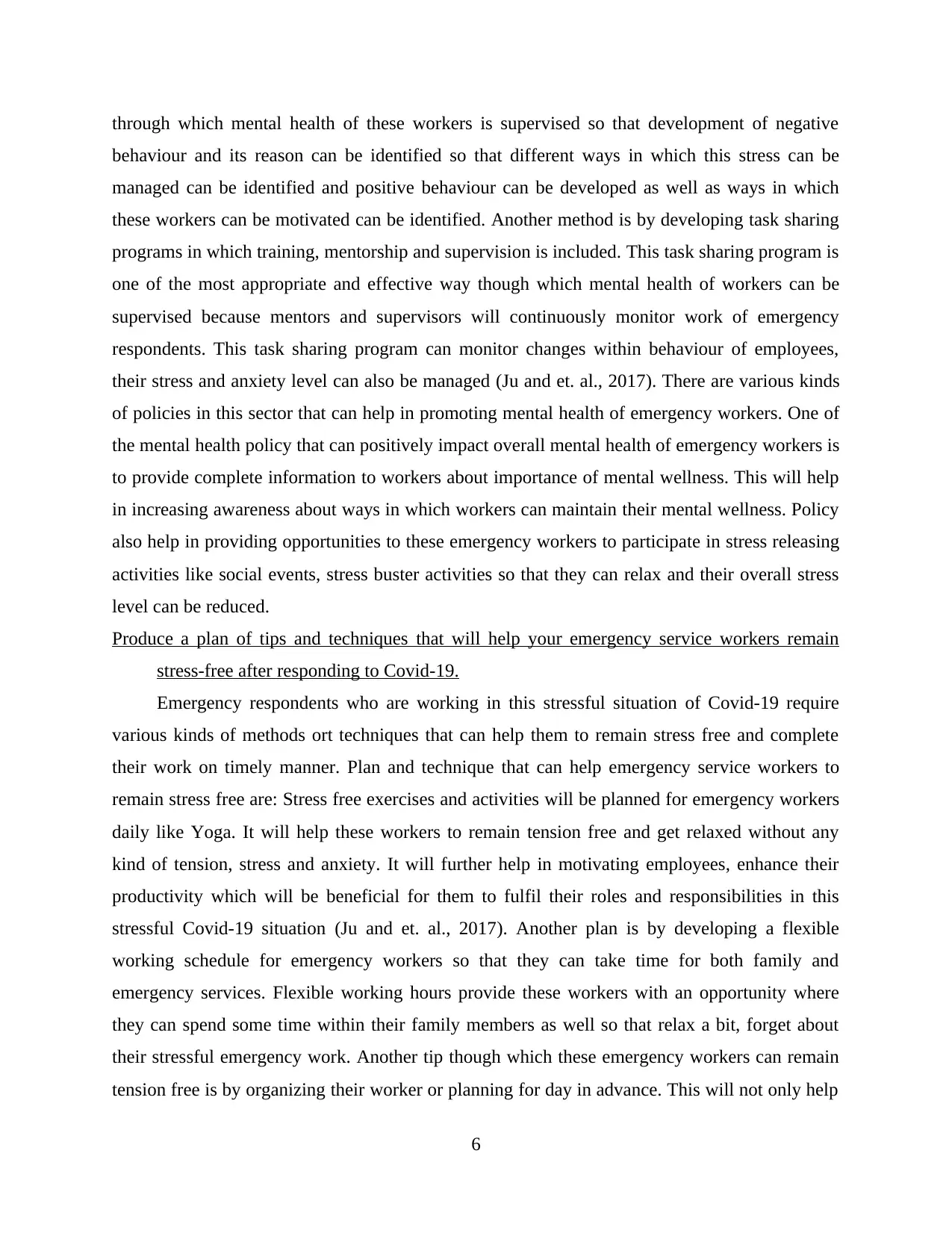
through which mental health of these workers is supervised so that development of negative
behaviour and its reason can be identified so that different ways in which this stress can be
managed can be identified and positive behaviour can be developed as well as ways in which
these workers can be motivated can be identified. Another method is by developing task sharing
programs in which training, mentorship and supervision is included. This task sharing program is
one of the most appropriate and effective way though which mental health of workers can be
supervised because mentors and supervisors will continuously monitor work of emergency
respondents. This task sharing program can monitor changes within behaviour of employees,
their stress and anxiety level can also be managed (Ju and et. al., 2017). There are various kinds
of policies in this sector that can help in promoting mental health of emergency workers. One of
the mental health policy that can positively impact overall mental health of emergency workers is
to provide complete information to workers about importance of mental wellness. This will help
in increasing awareness about ways in which workers can maintain their mental wellness. Policy
also help in providing opportunities to these emergency workers to participate in stress releasing
activities like social events, stress buster activities so that they can relax and their overall stress
level can be reduced.
Produce a plan of tips and techniques that will help your emergency service workers remain
stress-free after responding to Covid-19.
Emergency respondents who are working in this stressful situation of Covid-19 require
various kinds of methods ort techniques that can help them to remain stress free and complete
their work on timely manner. Plan and technique that can help emergency service workers to
remain stress free are: Stress free exercises and activities will be planned for emergency workers
daily like Yoga. It will help these workers to remain tension free and get relaxed without any
kind of tension, stress and anxiety. It will further help in motivating employees, enhance their
productivity which will be beneficial for them to fulfil their roles and responsibilities in this
stressful Covid-19 situation (Ju and et. al., 2017). Another plan is by developing a flexible
working schedule for emergency workers so that they can take time for both family and
emergency services. Flexible working hours provide these workers with an opportunity where
they can spend some time within their family members as well so that relax a bit, forget about
their stressful emergency work. Another tip though which these emergency workers can remain
tension free is by organizing their worker or planning for day in advance. This will not only help
6
behaviour and its reason can be identified so that different ways in which this stress can be
managed can be identified and positive behaviour can be developed as well as ways in which
these workers can be motivated can be identified. Another method is by developing task sharing
programs in which training, mentorship and supervision is included. This task sharing program is
one of the most appropriate and effective way though which mental health of workers can be
supervised because mentors and supervisors will continuously monitor work of emergency
respondents. This task sharing program can monitor changes within behaviour of employees,
their stress and anxiety level can also be managed (Ju and et. al., 2017). There are various kinds
of policies in this sector that can help in promoting mental health of emergency workers. One of
the mental health policy that can positively impact overall mental health of emergency workers is
to provide complete information to workers about importance of mental wellness. This will help
in increasing awareness about ways in which workers can maintain their mental wellness. Policy
also help in providing opportunities to these emergency workers to participate in stress releasing
activities like social events, stress buster activities so that they can relax and their overall stress
level can be reduced.
Produce a plan of tips and techniques that will help your emergency service workers remain
stress-free after responding to Covid-19.
Emergency respondents who are working in this stressful situation of Covid-19 require
various kinds of methods ort techniques that can help them to remain stress free and complete
their work on timely manner. Plan and technique that can help emergency service workers to
remain stress free are: Stress free exercises and activities will be planned for emergency workers
daily like Yoga. It will help these workers to remain tension free and get relaxed without any
kind of tension, stress and anxiety. It will further help in motivating employees, enhance their
productivity which will be beneficial for them to fulfil their roles and responsibilities in this
stressful Covid-19 situation (Ju and et. al., 2017). Another plan is by developing a flexible
working schedule for emergency workers so that they can take time for both family and
emergency services. Flexible working hours provide these workers with an opportunity where
they can spend some time within their family members as well so that relax a bit, forget about
their stressful emergency work. Another tip though which these emergency workers can remain
tension free is by organizing their worker or planning for day in advance. This will not only help
6
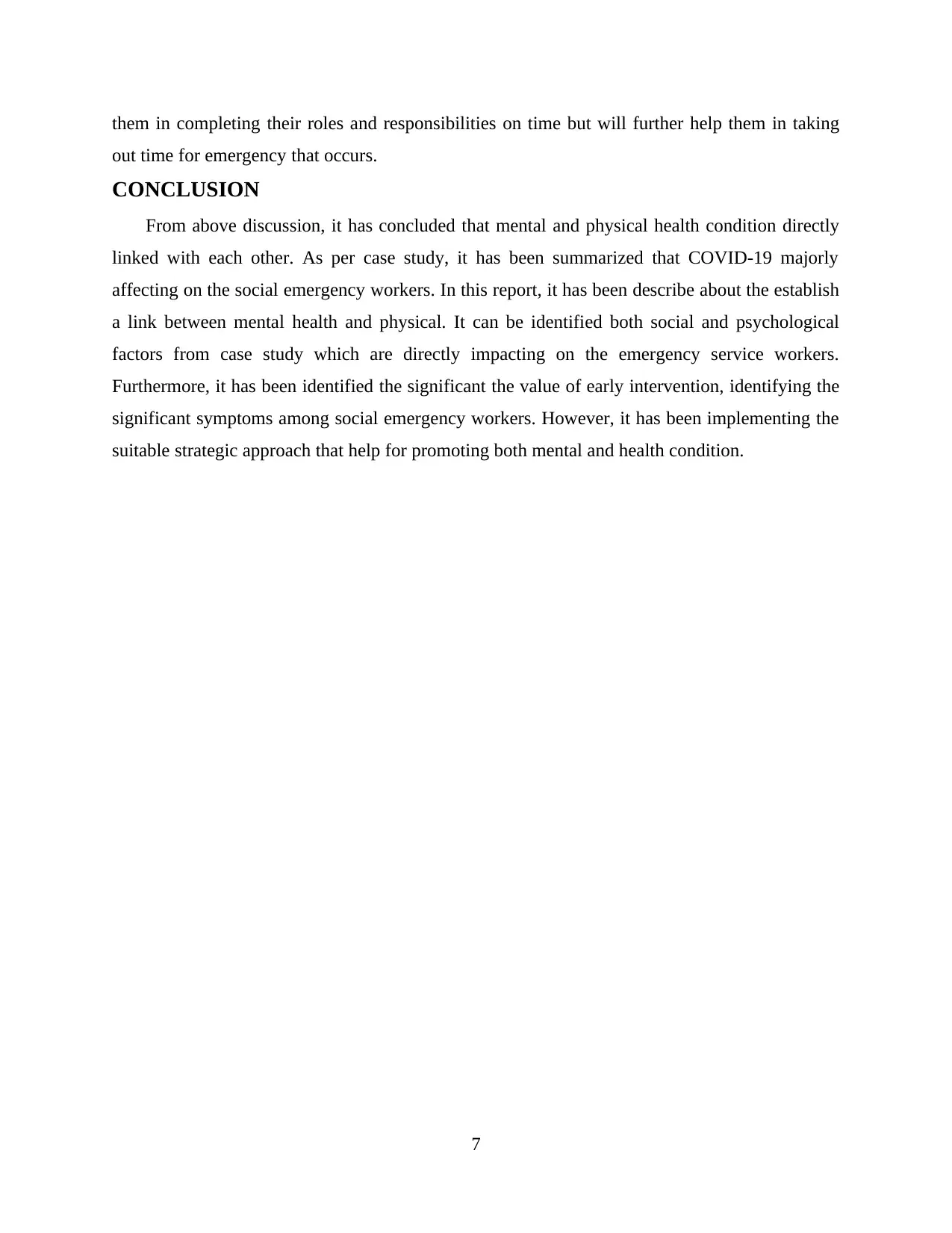
them in completing their roles and responsibilities on time but will further help them in taking
out time for emergency that occurs.
CONCLUSION
From above discussion, it has concluded that mental and physical health condition directly
linked with each other. As per case study, it has been summarized that COVID-19 majorly
affecting on the social emergency workers. In this report, it has been describe about the establish
a link between mental health and physical. It can be identified both social and psychological
factors from case study which are directly impacting on the emergency service workers.
Furthermore, it has been identified the significant the value of early intervention, identifying the
significant symptoms among social emergency workers. However, it has been implementing the
suitable strategic approach that help for promoting both mental and health condition.
7
out time for emergency that occurs.
CONCLUSION
From above discussion, it has concluded that mental and physical health condition directly
linked with each other. As per case study, it has been summarized that COVID-19 majorly
affecting on the social emergency workers. In this report, it has been describe about the establish
a link between mental health and physical. It can be identified both social and psychological
factors from case study which are directly impacting on the emergency service workers.
Furthermore, it has been identified the significant the value of early intervention, identifying the
significant symptoms among social emergency workers. However, it has been implementing the
suitable strategic approach that help for promoting both mental and health condition.
7
⊘ This is a preview!⊘
Do you want full access?
Subscribe today to unlock all pages.

Trusted by 1+ million students worldwide
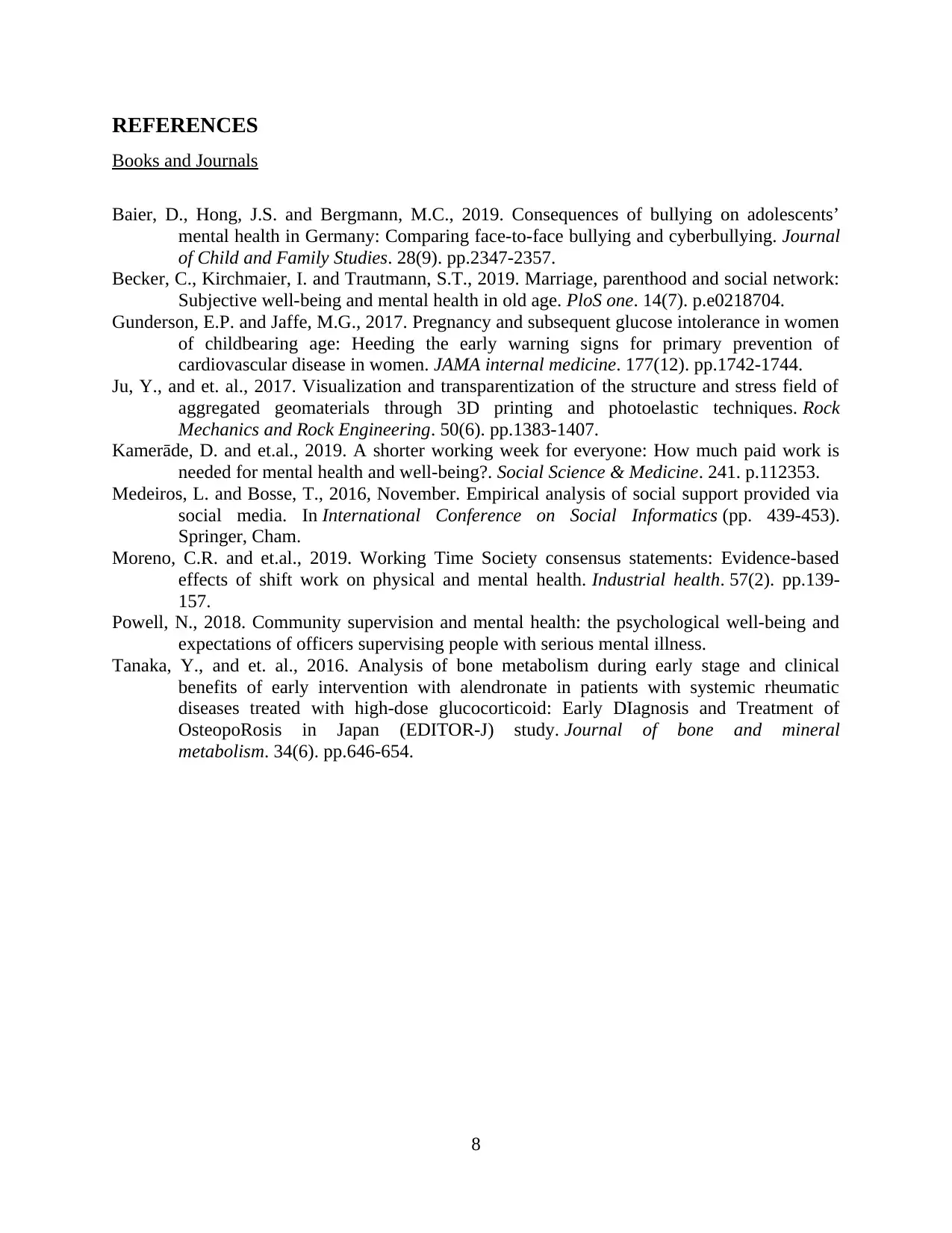
REFERENCES
Books and Journals
Baier, D., Hong, J.S. and Bergmann, M.C., 2019. Consequences of bullying on adolescents’
mental health in Germany: Comparing face-to-face bullying and cyberbullying. Journal
of Child and Family Studies. 28(9). pp.2347-2357.
Becker, C., Kirchmaier, I. and Trautmann, S.T., 2019. Marriage, parenthood and social network:
Subjective well-being and mental health in old age. PloS one. 14(7). p.e0218704.
Gunderson, E.P. and Jaffe, M.G., 2017. Pregnancy and subsequent glucose intolerance in women
of childbearing age: Heeding the early warning signs for primary prevention of
cardiovascular disease in women. JAMA internal medicine. 177(12). pp.1742-1744.
Ju, Y., and et. al., 2017. Visualization and transparentization of the structure and stress field of
aggregated geomaterials through 3D printing and photoelastic techniques. Rock
Mechanics and Rock Engineering. 50(6). pp.1383-1407.
Kamerāde, D. and et.al., 2019. A shorter working week for everyone: How much paid work is
needed for mental health and well-being?. Social Science & Medicine. 241. p.112353.
Medeiros, L. and Bosse, T., 2016, November. Empirical analysis of social support provided via
social media. In International Conference on Social Informatics (pp. 439-453).
Springer, Cham.
Moreno, C.R. and et.al., 2019. Working Time Society consensus statements: Evidence-based
effects of shift work on physical and mental health. Industrial health. 57(2). pp.139-
157.
Powell, N., 2018. Community supervision and mental health: the psychological well-being and
expectations of officers supervising people with serious mental illness.
Tanaka, Y., and et. al., 2016. Analysis of bone metabolism during early stage and clinical
benefits of early intervention with alendronate in patients with systemic rheumatic
diseases treated with high-dose glucocorticoid: Early DIagnosis and Treatment of
OsteopoRosis in Japan (EDITOR-J) study. Journal of bone and mineral
metabolism. 34(6). pp.646-654.
8
Books and Journals
Baier, D., Hong, J.S. and Bergmann, M.C., 2019. Consequences of bullying on adolescents’
mental health in Germany: Comparing face-to-face bullying and cyberbullying. Journal
of Child and Family Studies. 28(9). pp.2347-2357.
Becker, C., Kirchmaier, I. and Trautmann, S.T., 2019. Marriage, parenthood and social network:
Subjective well-being and mental health in old age. PloS one. 14(7). p.e0218704.
Gunderson, E.P. and Jaffe, M.G., 2017. Pregnancy and subsequent glucose intolerance in women
of childbearing age: Heeding the early warning signs for primary prevention of
cardiovascular disease in women. JAMA internal medicine. 177(12). pp.1742-1744.
Ju, Y., and et. al., 2017. Visualization and transparentization of the structure and stress field of
aggregated geomaterials through 3D printing and photoelastic techniques. Rock
Mechanics and Rock Engineering. 50(6). pp.1383-1407.
Kamerāde, D. and et.al., 2019. A shorter working week for everyone: How much paid work is
needed for mental health and well-being?. Social Science & Medicine. 241. p.112353.
Medeiros, L. and Bosse, T., 2016, November. Empirical analysis of social support provided via
social media. In International Conference on Social Informatics (pp. 439-453).
Springer, Cham.
Moreno, C.R. and et.al., 2019. Working Time Society consensus statements: Evidence-based
effects of shift work on physical and mental health. Industrial health. 57(2). pp.139-
157.
Powell, N., 2018. Community supervision and mental health: the psychological well-being and
expectations of officers supervising people with serious mental illness.
Tanaka, Y., and et. al., 2016. Analysis of bone metabolism during early stage and clinical
benefits of early intervention with alendronate in patients with systemic rheumatic
diseases treated with high-dose glucocorticoid: Early DIagnosis and Treatment of
OsteopoRosis in Japan (EDITOR-J) study. Journal of bone and mineral
metabolism. 34(6). pp.646-654.
8
1 out of 10
Related Documents
Your All-in-One AI-Powered Toolkit for Academic Success.
+13062052269
info@desklib.com
Available 24*7 on WhatsApp / Email
![[object Object]](/_next/static/media/star-bottom.7253800d.svg)
Unlock your academic potential
Copyright © 2020–2025 A2Z Services. All Rights Reserved. Developed and managed by ZUCOL.





